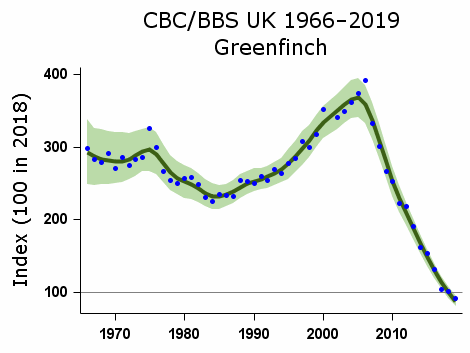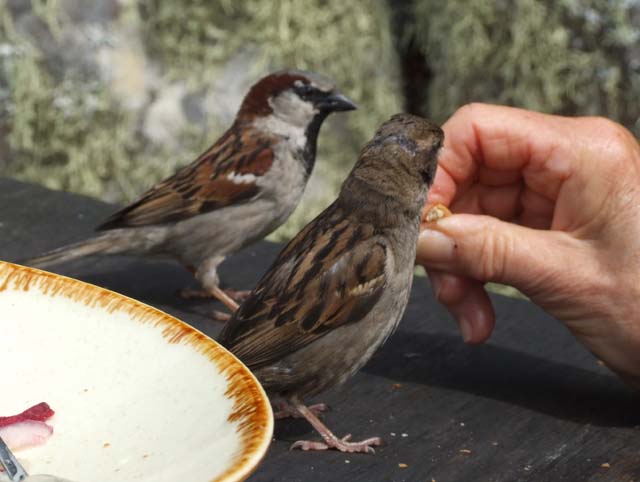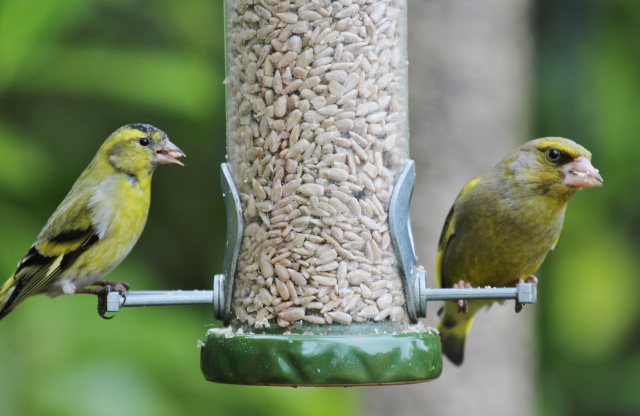An unusually prolonged exchange on a thread at Daily Sceptic, on the claims that we are in the midst of a mass extinction, put me in mind of the sudden decline in greenfinch numbers in the UK over the last few years.
I probably learned about this from one of the BBC Springwatch nature programmes before I even retired, and it has been kept in my mind by the astonishingly irregular visits of a pair of greenfinches to our garden feeder. They seem to turn up about once a year, invariably when one of our children’s families is visiting, so that the latter wonder why we suddenly get exercised, as a not uncommon bird is seen at breakfast. Me, I’m mystified about where they go the rest of the time.
Be that as it may, the decline since around 2005 is dramatic and significant, as this graph of UK numbers shows
To the Springwatch people, and no doubt to the RSPB and others, this decline seems to be a tragedy which somehow ought to be remedied by us, and is probably our fault – though the usual climate change culprit seems impossible to fit to the case. In fact, the major cause appears to be the spread of an infection – Trichomonas – from pigeons to greenfinches and, to a lesser extent, chaffinches. In fact, it’s become something of a test case for the under-explored role of disease in population changes.
Still, I’m always acutely aware that any such scare over a species’s decline relies on the kind of population survey that simply wasn’t performed until a few decades ago. Rather like the hole in the ozone layer, we have no idea how populations varied in the past. As for the present, a government report here said, of our birds, that “37% of species increased, 37% showed little change and 26% declined from 1970-2019.”
Environmentalists seem to take such data, routinely, as a sign of human destructiveness ranging from climate change to intensive farming. But in the absence of long-term information, not to mention scientific conclusions about its meaning, such a mixed bag is at least as compatible with the idea that natural populations of individual species always vary massively over time, often following a lemming-like boom and bust pattern. Such patterns were even mentioned by Darwin in his Origin of Species, as he described the quite profound changes in the mix of plants on a particular patch of ground from year to year.
In fact, the greenfinch graph shows just such a boom and bust picture, with a steep, steady, and unexplained increase from 1985 until the sudden turnaround in its fortunes. Was excessive population density somehow responsible for the new susceptibility to Trichonomiasis? Or is this year’s Springwatch gloom story, that insufficient bird-feeder hygiene may account for the problem, a better explanation?
The latter would be rather ironic, given how Britain has become a nation of obsessive wild bird feeders not simply because garden birds are a pleasure, but because we have been told they desperately needed our help, with climate change, habitat loss and all. I have some doubts about the infected feeder theory, since the original sources of the bug – pigeons – invariably feed on the stuff the greenfinches and other small birds drop from the feeder to the ground. But it’s certainly true (and is something we tend to ignore) that on the continent, where people are far less interested in garden birds, the greenfinches are doing just fine. So it is at least a possibility that our own finches are suffering from our good intentions.
But my main point is that, although it is a biblical principle that humanity is the steward of God’s earth, it’s far from clear that everything we try to help actually needs our help. In the greenfinch case, for example, the risk of extinction appears to revolve around the nature of infectious diseases. And as we have all learned a little over the COVID years, the chances of extinction from an infectious agent are probably negligible. Not only have immune systems developed to avoid such things, but there is no evolutionary advantage for an infectious agent to kill off its host population. The norm is to adapt to become endemic and relatively harmless.
The evidence for this, in the greenfinch’s case, is that fossils of the species have been found from the last ice-age. The species has warded off every bug nature has thrown at it, despite massive climate and habitat change, and Trichomonas is unlikely to be an exception.
Should we, then, be racked with guilt if it should turn out that Trichomonas has afflicted British greenfinches because we put up feeders and didn’t wash them often enough? I suggest not: we have done far worse for many centuries, and entirely accidentally in most cases. For example, nowadays we bewail the loss of farmland species because of the industrialisation of agriculture. And certainly, we should be cautious about the ignorant use of broad-spectrum pesticides, just as we should consider the effects of hoovering up North Sea sand-eels for fertilizer so efficiently that seabird populations collapse.
But just how common were those farmland birds before Neolithic farmers cleared the land and planted crops for the first time? How much habitat diversity was there when the wild oak wood covered most of the British Isles? No doubt many of those species were then as rare as they are now. Farming opened up Britain for previously cave-dwelling house sparrows, to the extent that in mediaeval times they ruined a substantial portion of the grain crop, and their huge numbers damaged the people’s thatched roofs too.
Now, plastic soffits and so on seem to be responsible for a decline in sparrow numbers (though there were plenty in the Isles of Scilly earlier this month, and even tamer than the robins, too). But do we owe them their old manner of life? If so, why?
The fortunes of different species vary with changes in human activity, in a way we probably can’t predict. Kestrels, for example, were like other raptors persecuted by 19th century gamekeepers, and benefited from the reduction in game-shooting in the Second World War. Many of us became familiar with them hovering over the new motorways – grass embankments no doubt being full of small prey. Their decline in the 1980s might well have been partly the result of these verges becoming covered with scrub, then trees. Since then the RSPB says English kestrels have fluctuated about a mean, whilst Scottish ones have declined for unknown reasons.
My suspicion is that they, in common with other species, have always varied in success from all kinds of causes, and that perhaps our concern to increase all wildlife is flying in the face of how the fluctuations of nature work. A bit like the fluctuations in climate.
It’s odd how the decline in belief in the God who is the Conservator of the natural world has, paradoxically, coincided with an increase in a sense of mankind’s exceptionality – though usually with an exaggerated sense of original sin by which we feel we are responsible for both destroying and saving the planet. Perhaps we should just “Let go, and let God.”



